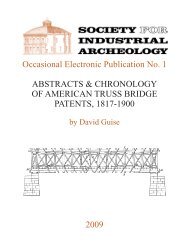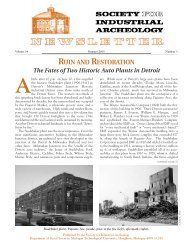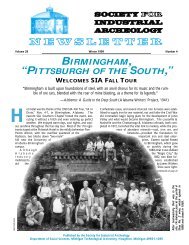RUHR, GERMANY - Society for Industrial Archeology
RUHR, GERMANY - Society for Industrial Archeology
RUHR, GERMANY - Society for Industrial Archeology
You also want an ePaper? Increase the reach of your titles
YUMPU automatically turns print PDFs into web optimized ePapers that Google loves.
The Ruhr Tour group in the central hall of the Zeche Friedrich-<br />
Heinrich coal mine.<br />
The plant’s primary product is strip steel, 50 percent of which is<br />
destined <strong>for</strong> the automotive industry. Its bow-type continuous<br />
casters produce 10-m. long slabs up to 2.5-m. wide and 255-mm.<br />
thick. Car manufacturers require 0.6 to 0.8-mm. thicknesses.<br />
Generally, hot rolling can get the slab down only to 1.5 mm., so it<br />
is followed by cold rolling. Thyssen-Krupp combines casting and<br />
hot rolling, able to produce thicknesses down to 0.8 mm and<br />
allows them to bypass cold rolling <strong>for</strong> some customers. Some sheet<br />
steel is rolled as thin as 0.1 mm <strong>for</strong> the packaging industry. (Steel<br />
is used more widely <strong>for</strong> soda cans in Europe than is aluminum.)<br />
The plant has the ability, with its five coating lines, to coat the<br />
steel with zinc or aluminum to prevent corrosion. Laser cutting<br />
and welding allows them to cut pre-fabricated pieces <strong>for</strong> the auto<br />
industry. Two million tons of rails also are produced here in<br />
lengths up to 120 m., which are shipped on eight flatcars. We were<br />
able to observe several pours of hot iron into the oxygen furnaces,<br />
stopped in at one of the blast furnaces, and saw the continuous<br />
casting process from beginning to end. The tour ended with a traditional<br />
steelworkers lunch - bread, beer and soup - in a company<br />
dining room.<br />
We next visited the Rheinisches Industriemuseum i n<br />
Oberhausen, housed in the <strong>for</strong>mer Altenberg zinc factory. The<br />
small museum’s exhibits describe the history of coal mining and<br />
steelmaking, beginning with the first deep mine, established in<br />
1830 by Franz Haniel, who also built the first coke-fired blast furnace<br />
in the Ruhrgebiet. The first iron used was “bog iron” found<br />
in a level of watery soil at the surface. Although Bessemer and<br />
Thomas steelmaking processes began to be used in the 1890s, puddling—to<br />
produce wrought iron—was still in use in the Ruhr as<br />
late as 1912. Seamless tube manufacturing was developed in 1885<br />
by Reinhard and Max Mannesmann, whose company is still headquartered<br />
in Dusseldorf. During World War II, workers from<br />
Poland, Russia, and France were <strong>for</strong>ced into labor to replace<br />
German men sent to the front. A Krupp diesel truck and locomotive<br />
were among the large items on display. In a partially recreated<br />
machine shop, staff demonstrated a lathe, which operated in<br />
the original zinc factory until ten years ago. A 53-ton <strong>for</strong>ging<br />
hammer is also on display.<br />
After 1830, the Ruhr’s rapid industrial growth resulted in competition<br />
<strong>for</strong> workers. Several workers’ housing settlements were<br />
on the itinerary, illustrating the coal and steel companies’ ef<strong>for</strong>ts<br />
to attract workers with, by American standards, quite lovely and<br />
<strong>Society</strong> <strong>for</strong> <strong>Industrial</strong> <strong>Archeology</strong> Newsletter, Vol. 30, No. 2, 2001<br />
com<strong>for</strong>table company towns. The R h e i n p r e u s s e n -<br />
Siedlung in Duisburg was built <strong>for</strong> coal miners in the<br />
Gartenstadt, or garden suburb, style and is one of the bestpreserved<br />
examples, with about 400 double-houses<br />
remaining. Siedlung Teutoburgia in the town of Herne<br />
once housed 7,000 people. The tree-lined main street, or<br />
allée, led directly to the mine entrance, a common feature<br />
of the mines in the area. The mine’s headframe and hoist<br />
house, dating from 1907-08, still remain and have been<br />
incorporated into a park that includes artistic installations.<br />
One of these, called the “Haunting of the Deep,” imitates<br />
a covered mine shaft, with howling sounds emanating<br />
from speakers mounted underneath the wooden plat<strong>for</strong>m.<br />
It was one of several examples we saw of art being incorporated<br />
into historic industrial sites as a way to redefine<br />
them as cultural landscapes and attract people.<br />
Next, we traveled to Wuppertal where we rode the<br />
Schwebebahn. The world’s oldest operating monorail, the<br />
Schwebebahn (literally, “suspended way"), is suspended<br />
from a single rail. It was built between 1898 and 1903 to<br />
create public transportation in minimal space along the narrow<br />
valley of the Wupper River. For most of its 13.3-km. length it runs<br />
12 m. above the river. Its 472 steel arches spanning the riverbed<br />
are being replaced and many of the stations are being restored.<br />
Bochumer Verein Verkehrstechnik GmbH ( B o c h u m<br />
Association <strong>for</strong> Transportation Engineering, Inc.), in the city of<br />
Bochum, was begun in 1842 and was originally part of an early<br />
Krupp steel works. The wheel foundry includes a showroom of<br />
locomotive wheels. We then saw the process from its beginning,<br />
where blanks were cut from billets, heated in a natural gas-fired<br />
furnace, and descaled. The main <strong>for</strong>ge provided drama as the redhot<br />
blanks were moved by conveyor and robot under the hammer.<br />
Coal powder burst into flame as it was dropped onto the blank as<br />
a lubricant. An operator uses tongs to insert a mandral and, once<br />
the press punches out the axle hole, retrieves the mandral from a<br />
continued on page 6<br />
The SIA Newsletter is published quarterly by the <strong>Society</strong> <strong>for</strong> <strong>Industrial</strong><br />
A r c h e o l o g y. It is sent to SIA members, who also receive the <strong>Society</strong>’s<br />
journal, I A, published annually. SIA promotes the identification, interpretation,<br />
preservation, and re-use of historic industrial and engineering<br />
sites, structures, and equipment. Annual membership: individual $35;<br />
couple $40; full-time student $20; institutional $40; contributing $60;<br />
sustaining $125; corporate $250. Send check or money order payable<br />
in U.S. funds to the <strong>Society</strong> <strong>for</strong> <strong>Industrial</strong> <strong>Archeology</strong> to SIA-HQ,<br />
Dept. of Social Sciences, Michigan Technological University, 1400<br />
Townsend Drive, Houghton, MI 49931-1295; (906) 487-1889; e-mail:<br />
S I A @ m t u . e d u ; Web site: w w w. s s . m t u . e d u / I A / S I A . h t m l .<br />
Mailing date <strong>for</strong> Vol. 30,1 (Spring 2001), June 2001. If you have not<br />
received an issue, apply to SIA-HQ (address above) <strong>for</strong> a replacement<br />
copy.<br />
The SIA Newsletter welcomes material and correspondence from members,<br />
especially in the <strong>for</strong>m of copy already digested and written! The<br />
usefulness and timeliness of the newsletter depends on you, the reader,<br />
as an important source of in<strong>for</strong>mation and opinion.<br />
TO CONTACT THE EDITOR: Patrick Harshbarger, Editor, SIA<br />
Newsletter, 305 Rodman Road, Wilmington, DE 19809; (302) 764-<br />
7464; e-mail: phsianews@aol.com.<br />
5






